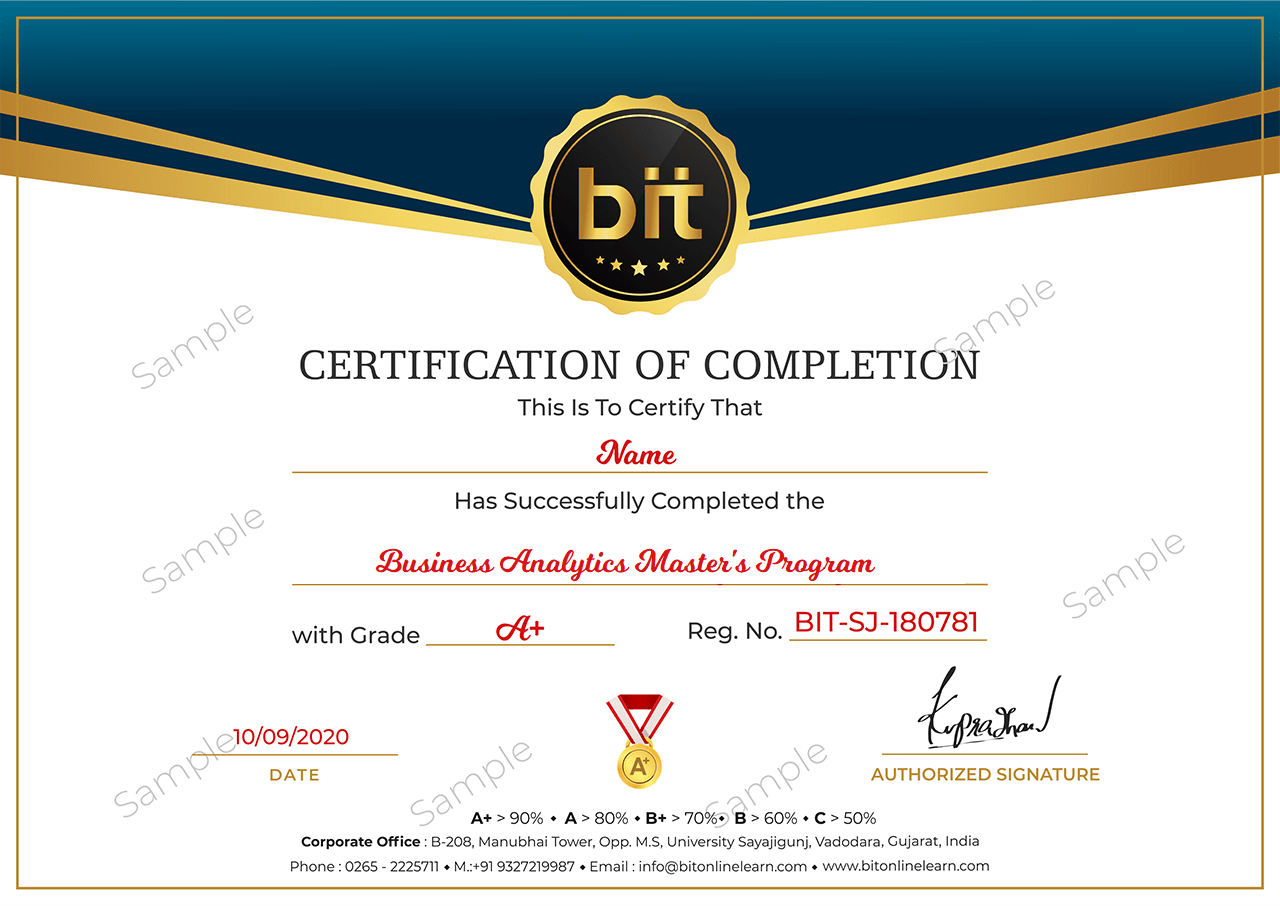|
|
Lecture-1 Power BI Architecture
· Components of Power BI Architecture
· Data Sources
· Power BI Desktop
· Power BI Service
· Power BI Report Server
· Power BI Gateway
· Power BI Mobile
· Power BI Embedded
· Working of Power BI Architecture
· On-Premise
· On-Cloud
· Power BI Service
· Front End cluster
· Back End cluster
· Working of Power BI Service
· Azure block /storage
· Azure SQL database
· Practical Exercise
|
|
|
|
|
Lecture-2 Power BI Building Blocks
· Introduction
· Visualizations
· Datasets
· Reports
· Dashboards
· Tiles
· Practical Exercise
|
|
|
|
|
Lecture-3 Power BI Components
· What is Power BI
· Power Query
· Power Pivot
· Power View
· Power Map
· Power BI Desktop
· Power BI Website
· Power Q&A
· Power BI Mobile Apps
· Practical Exercise
|
|
|
|
|
Lecture-4 Power BI-Installation
· List of Operating System which supports Power BI
· Supported Operating Systems
· How to Install Power BI in PC (Windows)
· Practical Exercise
|
|
|
|
|
Lecture-5 Power BI Data Modeling
· What is Power BI Data Modeling?
· Using information Modeling and Navigation
· How to Create Power BI Dashboard?
· Report Tab
· Data Tab
· Relationships Tab
· Create Workspace in Power BI
· Create Calculated Columns in Data Modeling
· Creating Calculated Table in Data Modeling
· Managing Time-Based Information
· Practical Exercise
|
|
|
|
|
Lecture-6 Power BI-Create Workspace and Dashboard
· Create Groups in Power BI
· Introduction to Reports and dashboards
· Alter dashboards in Power BI
· Customer DataSet
· Order DataSet
· Sales DataSet
· Region DataSet
· Product DataSet
· Deployment Channels in Power BI Custom Visuals
· Dashboard Vs. Report
· Practical Exercise
|
|
|
|
|
Lecture-7 Share and view Dashboard
· Imparting Power BI Dashboard
· Power BI recognizes “an association”
· Ways to Share Power BI Dashboard
· Share Power BI with Internal Clients and External Clients
· View of Dashboards on Different Devices like IPhone, iPad, Android Phone, Android Tablet, Windows 10, etc.
· Practical Exercise
|
|
|
|
|
Lecture-8 Introduction to Power BI Desktop and connecting to data
· Benefits of Power BI Desktop
· Installing Power BI Desktop
· Power BI Work Area
· Connect to Data in Power BI Desktop
· Practical Exercise
|
|
|
|
|
Lecture-9 Q & A in Power BI Desktop
· Introduction
· Include Missing Connections
· Rename Tables and Segments
· Fix Mistaken Data Composes
· Check year and Identifier Segments as Don’t Summarize
· Pick a Sort By Column for Important Sections
· Standardize your Model
· New Tables for Multi-Segment Elements
· Practical Exercise
|
|
|
|
|
Lecture-10 Power BI Archived Workspace
· What is Power BI Archived Workspace?
· Confinements in your Archived Workspace in Power BI
· OneDrive for Business
· Sharing Dashboards
· Creating Gatherings
· Access on Power BI Versatile Applications
· Moving Content in your Power BI Archived Workspace
· Excel or Power BI Desktop Datasets
· Other Datasets
· Reports
· Dashboards
· Power BI Archived Workspace in Office 365
· Practical Exercise
|
|
|
|
|
Lecture-11 Data Sources for Power BI
· Introduction and Types of Data Sources for Power BI Services
· Files
· Content Packs
· Databases
· How Data Originates from an Alternate Source?
· Some More Subtle Elements
· Data Invigorate
· Contemplations and Limitations
· Data Sources in Power Metal Desktop
· All Class
· File Class
· Database Class
· Power Metal Class
· Azure Class
· Online Service Class
· Other Class
· Connect a Data Source in Power BI
· Practical Exercise
|
|
|
|
|
Lecture-12 Power BI Admin Roles
· Purchasing
· REST API
· Security
· Practical Exercise
|
|
|
|
|
Lecture-13 DAX in Power BI
· Introduction and Importance of DAX in Power BI
· DAX Formula & Syntax
· DAX Calculation Types
· DAX Functions
· Date and Time Functions
· Time Intelligence Functions
· Information Functions
· Logical Functions
· Mathematical and Trigonometric Functions
· Statistical Functions
· Text Functions
· Parent-Child functions
· Table functions
· Row context
· Filter Context
· Creating a Measure Formula using DAX
· Practical Exercise
|
|
|
|
|
Lecture-14 Power BI and Excel Integration
· Microsoft Power BI and Excel
· Integration of Power BI and Excel
· Existing Dashboard in Power BI
· Practical Exercise
|
|
|
|
|
Lecture-15 Integration of Microsoft Flow and Power BI
· Make a Microsoft Flow that Utilizes Power BI from a Layout
· Fabricate the Microsoft Flow
· Construct your Microsoft Flow
· Practical Exercise
|
|
|
|
|
Lecture-16 Table in Power BI
· Utilize a Power BI Table
· Create a Table in Power BI
· Arrange a Table in Power BI
· Contingent Arranging in Power BI Table
· Change the Segment Width of a Table
· Practical Exercise
|
|
|
|
|
Lecture-17 Power BI Conditional Formatting
· Background Shading Scale
· Shade Color by Rules in Table
· Shade Color Least to Most Extreme in Table
· Shade Color Text Style in Table
· Shade Color Information Bars
· Practical Exercise
|
|
|
|
|
Lecture-18 Power BI Gateway
· Standard Mode
· Personal Mode
· Power BI Gateway Architecture
· Cloud Services
· Gateway Services
· On-premises Data Sources
· Use Gateway in Power BI
· Install Power BI Gateway
· Adding a Data Source for Gateway
· Gateway Connection Set up to a Dataset
· Troubleshooting of Power BI Gateway
· Practical Exercise
|
|
|
|
|
Lecture-19 Power BI Filters
· Order Dataset
· Sales Dataset
· Customer Dataset
· Region Dataset
· Product Dataset
· Visual-level Filters
· Page-level Filters
· Report-level Filters
· Drillthrough Filters
· Apply a Filter in Power BI Desktop
· Applying Filter to a Visual
· Applying Filter to a Page
· New Filter Pane Experience in Power BI Desktop
· Add Filter Pane for all New Reports
· Add Filter Pane for an Existing Report
· Format the Filter Pane
· Apply Filters in Power BI Workspace
· Adding Filter in Edit Report Mode
· Filters in Reading view mode
· Practical Exercise
|
|
|
|
|
Lecture-20 Power BI Query
· Report See
· Information See
· Connections See
· Power BI Query Editor
· Inquiry Strip
· Left Sheet (Pane)
· Inside (information) Sheet
· Question Settings Sheet
· The Advanced Editor
· Sparing your Work
· Practical Exercise
|
|
|
|
|
Lecture-21 Power BI Slicers
· Date Slicer
· Numeric Range Slicer
· Sync Slicers
· Formatting the Slicer
· Practical Exercise
|
|
|
|
|
Lecture-22 Power BI API
· Admin Operations
· Available Features Operations
· Capacities Operations
· Dashboards Operations
· Datasets Operations
· Embed Token Operations
· Gateways Operations
· Groups Operations
· Imports Operations
· Reports Operations
· Operation group Description
· Dashboards GetDashboardsAsAdmin
· Dashboards GetDashboardsInGroupAsAdmin
· Dashboards GetTilesAsAdmin
· Datasets GetDatasetsAsAdmin
· Datasets GetDatasetsInGroupAsAdmin
· Datasets GetDatasourcesAsAdmin
· Gatherings AddUserAsAdmin
· Gatherings DeleteUserAsAdmin
· Gatherings RestoreDeletedGroupAsAdmin
· Gatherings UpdateGroupAsAdmin
· Imports GetImportsAsAdmin
· Reports GetReportsAsAdmin
· Reports GetReportsInGroupAsAdmin
· Power BI Accessible Features
· Power BI Capacities API
· Practical Exercise
|
|
|
|
|
Lecture-23 Power BI Rest API
· Include Dashboard
· Include Dashboard In Group
· Clone Tile
· Clone Tile In Group
· Get Dashboard
· Get Dashboard In Group
· Get Tile
· Get Tile In Group
· Power BI Embed Token API
· Power BI Gateways API
· Power BI Group API
· Limitations
· Power BI Import API
· Power BI Push Datasets API
· Power BI Reports API
· Practical Exercise
|
|
|
|
|
Lecture-24 KPI and Mobile Apps
· What are KPIs?
· KPI Elements in Power BI
· Uses of KPIs in Power BI
· Requirements for Creating KPI in Power BI
· KPI Custom Visualizations
· Considerations and Troubleshooting
· Power BI Apps on Mobile Gadgets
· Power BI Apps for Various Gadget
· Configure Power BI Apps with Microsoft Intune
· General Mobile Gadget Administration Setup
· Practical Exercise
|
|
|
|
|
Lecture-25 Custom Visuals and Custom Visualization
· Developing Custom Visuals in Power BI
· Custom visual files
· Organizational visuals
· Marketplace visuals
· Downloading and Importing Custom Visuals from Microsoft AppSource
· Essentials for Power BI Customization
· Power BI Customize Visualization Backgrounds
· Power BI Customize Visualization Legends
· Visualization Types that can Customize in Power BI
· Practical Exercise
|
|
|
|
|
Lecture-26 Card Visualizations and Matrix Visualization
· Create a Power BI Card with Report Editor
· Create Power BI Card from the Q&A Question Box
· Considerations and Troubleshooting
· Power BI Matrix Visualization
· Seeing How Power BI Ascertains Aggregates
· Utilizing Drill-Down with Power BI Matrix Visual
· Power BI Matrix Visuals – Ventured Design
· Subtotals with Matrix Visuals in Power BI
· Cross-Featuring with Power BI Matrix Visuals
· Shading & Textual Style Hues with Matrix Visuals
· Practical Exercise
|
|
|
|
|
Lecture-27 Hyperlinks and Bookmarks
· Create Hyperlink in Power BI Desktop
· Make a Table or Network Hyperlink in Power BI Desktop
· Make a Table or Grid Hyperlink in Excel Power Pivot
· What is the Power BI Bookmark?
· Empower – Power BI Bookmarks
· Utilize Power BI Bookmark
· Organize Bookmarks in Power BI
· Power BI Bookmark as a Slide Appear
· Perceivability – Utilizing the Selection Sheet
· Power BI Bookmarks for Shapes & Pictures
· Utilizing Spotlight
· Power BI Bookmarks in Power BI Benefit
· Practical Exercise
|
|
|
|
|
Lecture-28 Importing Excel Workbooks into Power BI Desktop
· How would We Import an Excel Sheet into Power BI (manually)?
· Power Inquiry Queries
· Power Turn Outside Information Connections
· Connected Tables or Current Exercise Manual Tables
· Information Show Ascertained Segments and Others
· Power View Worksheets
· Constraints to Bringing in Excel Workbook Manual
· Practical Exercise
|
|
|
|
|
Lecture-29 Power BI Data Category
· Data Categorization in Power BI Desktop
· How to Determine Power BI Data Category?
· Recognize Geographic Information in Report
· Make Visuals with Your Geographic Information
· View the Report in Power BI Portable Application
· Practical Exercise
|
|
|
|
|
Lecture-30 Power BI Aggregate
· What is Power BI Aggregate?
· Kinds of Data (Information)
· Working of Aggregation in Power BI
· Change How a Numeric Field is Amassed
· Aggregate your Data in Power BI
· Make a Total Utilizing a Classification (Content) Field
· Practical Exercise
|
|
|
|
|
Lecture-31 Admin Portal
· Power BI Administrator Portal
· Instructions to get Administrator Entry
· Usage Measurements
· Manage Clients (User)
· Audit Logs
· Tenant Settings
· Workspace Settings
· Fare and Sharing Settings
· Content Pack Settings
· Joining Settings in Power BI Portal
· Utilize Analyze in Excel with On-Premises Datasets
· Power BI Custom Visuals Settings
· R Visuals Settings
· Review and Use Settings
· Power BI Dashboard Settings
· Power BI Designer Settings
· Limit Settings
· Implant Codes
· Power BI Association Visuals
· Practical Exercise
|
|
|
|
|
Lecture-32 ArcGIS, Shape and Tree Map
· What is ArcGIS, Shape, and Tree Map?
· Client Assent
· Empower ArcGIS Outline
· Make an ArcGIS Delineate
· Settings and Organizing for ArcGIS Maps
· When to Utilize Power BI Treemap
· Featuring and Cross-Sifting
· Create Shape Map in Power BI
· How to Utilize Custom Maps?
· Test Custom Map
· Getting Map Information
· Review Conduct and Prerequisites
· Practical Exercise
|
|
|
|
|
Lecture-33 Types of Chart
· BI Scatter Charts & Bubble Charts
· Combo Chart
· Basic Area Chart
· Funnel Charts
· Donut Chart
· Waterfall Chart
· Radial Gauge Chart
· Ribbon Chart
· Time Series Chart
· Featuring and Cross-Sifting
· Practical Exercise
|
|
|
|
|
Lecture-34 Power BI Premium Capacity
· Memory Administration
· CPU Asset Administration in Premium Capacity of Power BI
· Investigating and Testing
· Practical Exercise
|
|
|
|
|
Lecture-35 Relationship View
· Autodetect Amid Stack
· How to Make a Power BI Relationship?
· Arrange Extra Alternatives
· Power BI Cardinality
· Make the New Relationship in Power BI
· Extra Choices for Relationship in Power BI
· Information Require an Alternate Cardinality
· Practical Exercise
|
|
|










